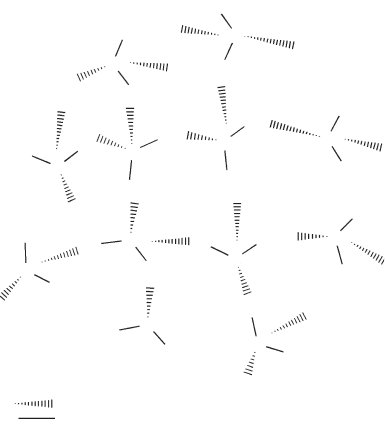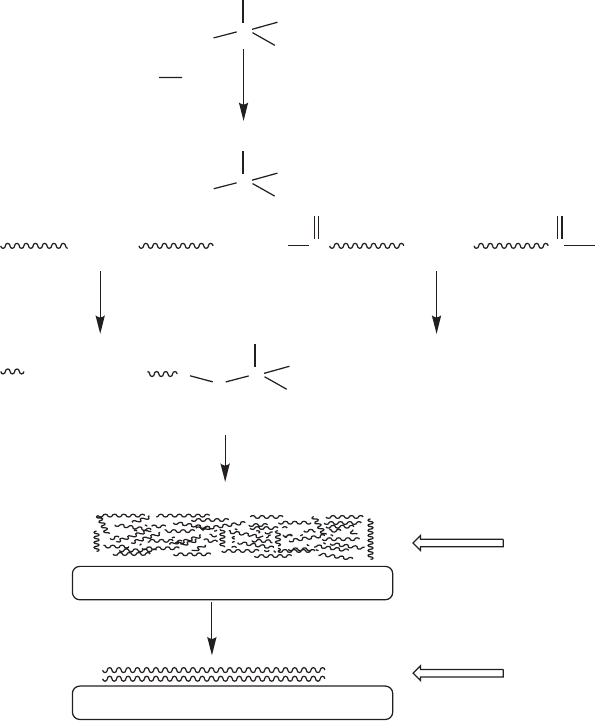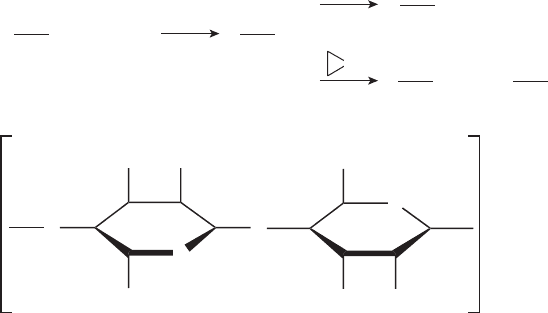Khanna A.S. (Ed.) High-Performance Organic Coatings: Selection, application and evaluation
Подождите немного. Документ загружается.

246 High-performance organic coatings
surface tension and go up to the top and spread there, suppressing the
material that has been on the top before. Again the diluent evaporates and
a circulation starts; this is repeated until the wet paint is no longer move-
able, due to increased viscosity. This circulation results in hexagonal cells
(under ideal conditions), called Benard cells. In coatings we can see the
results of this effect as ‘orange peeling’ or horizontal pigment separation.
the ingredients with the lowest surface tension, i.e. they migrate to the top
and spread there in a very thin layer (from a monolayer to one some
molecules thick). As there is nothing in the paint formulation that has a
lower surface tension, there will be no circulation in the paint during drying.
Of course, in reality the above-mentioned effects are always overlapping,
but depending on the paint formulation and/or the chemical structure of
the siloxane-polyether copolymer, one or the other effect dominates. Quite
often the best results are achieved by combinations of different structures
truly synergistic one, not just an addition of the single effects.
Now, after adding siloxanes (or modified siloxanes), without doubt they are
Smooth films without Benard cell-related defects will be achieved.
that influence different parameters, and quite often the resulting effect is a
© 2008, Woodhead Publishing Limited

247
13
Waterborne coatings for corrosion protection
S S PATHAK and A S KHANNA, Department of
Metallurgical Engineering & Materials Science, India
13.1 Introduction
A conventional coating consists of a resin, pigments and additives, dis-
persed in a suitable solvent. Film formation and solvent evaporation start
simultaneously after coating application. Complete evaporation of solvent
is a must for complete curing of a coating. However, evaporation of solvents
during the curing process affects the health not only of the paint applicators
but also of persons in the vicinity. The most commonly used solvents are
toluene, xylene, methylethylketone, etc. Some of the health effects caused
by these solvent vapours are cardiac arrhythmia, fatigue, sleepiness, head-
aches and nausea, and irritation of the nose, throat and eyes.
13.2 Alternatives to solventborne coatings
Due to the diverse effects on human health and the environment, stricter
legislation has been imposed on the paint and coating industries to reduce
and monitor the amount of hazardous volatile solvents. There are two pos-
sible ways to make coating formulations environmentally friendly:
• Use of solvents that are not hazardous to health and the environment
as well as use of hazardous vapour collection equipment during applica-
tion of coatings.
• Development of waterborne coatings, high solid coatings and solvent-
less coatings.
A brief introduction to these alternative coating technologies is presented
in Table 13.1. The alternative paint formulations are high build systems
where the solvent level is reduced to less than 15–20%, and solventless
systems where the solvent level is reduced to 1–5% by volume. An addi-
tional formulation is to use alternative solvents such as water, which is
available abundantly and is much cheaper. This class of coating is called
waterborne coatings.
© 2008, Woodhead Publishing Limited

248 High-performance organic coatings
13.3 Waterborne coatings
Waterborne means something derived from water. A coating formulation
that utilizes water as the main volatile medium (at least 80% water as the
main volatile medium) to disperse its components is called a waterborne
coating. Most regulations require waterborne coatings to have a VOC of
less than 425 g per litre of paint. The increasing importance of waterborne
coatings also lies in the environmental as well as the biological importance
of water, which is highlighted by the water-covered Earth and the essential-
ity of water to all known forms of life. Water has been referred to as the
naturally occurring universal solvent.
Many types of resins are available in a waterborne version, including vinyls,
two-component acrylics, epoxies, polyesters, styrene-butadiene, amine-
solubilized, carboxyl-terminated alkyd and urethanes. Waterborne coatings
of the polymer particles they contain (Table 13.2). The three main types
are water-soluble/water-reducible (solutions), water-dispersible/colloidal
(dispersions) and emulsions (latex) paints (the most commonly used form).
Within each category, the physical properties and performance depend on
Table 13.1 Environment-friendly alternative coating technologies
Nomenclature % Solid
content
Advantages Disadvantages
High-build
coatings
60–80% Higher thickness per
coat, low VOC
High viscosities, slight
application
Solventless
coatings
100% Very high thickness per
coat
Costly equipment;
airless spray technique
used for coating
Waterborne
coating
Same as
solvent-
borne
system
Low VOC emission; low
viscosity; reduced
toxicity; no odour and
tional application pro-
cesses; suitable for thin
Resins for waterborne
formulations are costly
compared with
conventional coatings;
tendency to form
foam; requires longer
drying times or
increased oven
temperatures
difficulty in brush
film application
13.4 Classification of waterborne coatings
the type of resin used [1]. Before discussing the specific features of water-
non-flammable; conven-
can be classified either on the basis of how the resin is fluidized or in terms
© 2008, Woodhead Publishing Limited

Waterborne coatings for corrosion protection 249
Water-soluble/water-
reducible (solutions)
Water-dispersible/
colloidal (dispersions)
Emulsion
Paints whose individual
molecules of water-soluble
resins dissolve completely in
water.
Paints that have small
clusters of insoluble
solid resin particles that
are suspended in water.
Emulsions are
formed from
dispersion of liquid
in polymer in
water.
Water-soluble resins are
generally produced via
polycondensation or polym-
erization reactions in an
organic medium.
Mechanical agitation is
the clusters.
On the basis of size of resin particle
True solution Dispersion Emulsion
<0.01 μm 0.01–0.1 μm 0.1–1.0 μm
borne coatings, a basic introduction to the physical properties of water
which are dramatically different from those of solvents used in coatings, is
necessary. The effects of these unique properties on the performance of
waterborne systems are outlined below.
the recipe of the coating as well as its end user properties will be discussed.
The surface tension, evaporation rate and freezing point of water are dra-
matically different from those of other solvents used in coating formula-
tions. The explanation for water’s unusual behaviour lies in its molecular
structure.
13.5.1 Polarity
Water (H
2
O) is a polar molecule consisting of two hydrogen atoms cova-
lently bonded to a single oxygen atom. The oxygen pulls the electron of the
hydrogen towards itself because of the higher electronegativity of oxygen
than that of the hydrogen atom. This accumulation of electrons towards the
oxygen leads to the generation of a negative charge on the oxygen and a
positive charge on the hydrogen.
Table 13.2 Classification of waterborne coatings
sufficient to suspend
On the basis of resin fluidization
13.5 Water properties influencing coating formulation
In this section, the physical and chemical nature of water that influences
© 2008, Woodhead Publishing Limited

250 High-performance organic coatings
13.5.2 Association of water
The three-dimensional water molecule is held together by strong hydrogen
bonding between oxygen and hydrogen (Fig. 13.1). The hydrogen-bonded
structure of water makes it more resistant to cleavage by normal molecular
vibration. Therefore, hydrogen bonding increases the heat energy require-
ment for the conversion of water to vapour as compared to other solvents
used in coating formulations. The high surface tension of water is also
caused by strong cohesion between the water molecules. Various properties
of water are compared with those of solvents widely used in coating for-
mulations in Table 13.3.
13.5.3 Freezing
The higher freezing point of water than that of organic solvents of intro-
duces the need for special storage systems in climates where low tempera-
tures are possible. The storage temperature should be at least 10°C. The
anomalous density/temperature characteristics of water should also be con-
sidered, to avoid thaw, separation and/or coagulation of the coating formu-
lation during storage.
H
H
H
H
H
H
H
H
H
H
H
Hydrogen bond
Covalent bond
H
H
H
H
H
H
H
H
H
H
H
H
H
O
O
O
O
O
O
O
O
O
O
O
O
13.1 Association of water molecules.
© 2008, Woodhead Publishing Limited

Waterborne coatings for corrosion protection 251
13.5.4 Evaporation rate
Complete evaporation of the solvent from the coating is necessary and is
the most important criterion for a good coating formulation. The evapora-
tion rate of the solvent depends on the boiling point and latent heat of
vaporization. As with surface tension, water has a high value for the latent
heat of vaporization as compared to solvents used in coating formulations
(Table 13.3). Therefore, waterborne coatings use up more heat energy for
the complete evaporation of water than do solventborne coatings for the
evaporation of the solvent. Also, the rate of evaporation of water, unlike
sphere. At higher relative humidity, the capacity of the atmosphere to
accept more water vapour decreases. This leads to a slower rate of evapora-
tion of water from waterborne coatings.
13.5.5 Surface tension
The surface tension of a coating formulation is related to the wetting and
adhesion of the coating to the substrate. For good wetting, the surface
Table 13.3 Properties of water in comparison to various solvents and
substrates
Properties Solvents
Water Acetone Xylene White spirit
Melting point
(°C)
0 −94 −25
Boiling point
(°C)
100 56 138–142 152–198
Flash point (°C) −17 25 36–41
capacity
73 24 30 18
Latent heat of
vaporization
(cal/g at b.p.)
540 135 94 115
Surface tension (dyne/cm)
Solvent (in
air at 20°C)
Water 72.8 Xylene 28.2 C
2
H
5
OH 22.7 CHCl
3
26.8 Benzene
28.8
Substrate
Treated
steel 40–50
Aluminium
45
Untreated
steel 30
Glass
70–80
Specific heat
non-flammable
Teflon 18
that of organic solvents, is influenced by the relative humidity of the atmo-
© 2008, Woodhead Publishing Limited
252 High-performance organic coatings
tension of the coating formulation should be lower than that of the sub-
strate on which it has to be applied. Table 13.3 shows that water has a very
high surface tension when compared to widely used solvents for coating
formulations as well as common substrates. Therefore, waterborne coatings
bility, non-toxicity and easy availability of water favour its use as a potential
solvent for coating formulations. Also, strict regulations on the use of non-
toxic materials for coating formulations have encouraged greater use of
water in industrial coatings [2].
13.6 Technology behind development of
waterborne coatings
13.6.1 Development of water soluble/reducible resin
In this section, the techniques of synthesis of water-soluble/reducible poly-
discussed. Such moieties are water loving or can be made water loving after
using one of the following techniques:
• Salt formation, or simply the incorporation of carboxylic or amino
groups onto the backbone of the polymer. These can be converted into
anions or cations by a number of acid–base reactions.
• Introduction of non-ionic groups such as polyols or polyethers into the
backbone. These polymers are of lower molecular weight and can
remain water-sensitive.
• The formation of intermediate zwitterions (groups containing both posi-
tive and negative charge).
13.6.2 Development of sol-gel derived waterborne coatings
Apart from conventional techniques of waterborne coating formulation,
the sol-gel process [3] is one of the emerging technologies for the develop-
ment of high-performance waterborne coatings. It has provided a new tool
through the in situ formation of an inorganic network by hydrolysis and
polycondensation of metal alkoxide R(MX
3
)
n
where X = OR, R, H, Cl and
M = Ti, Si, Zr as shown in Table 13.4.
Silicon alkoxides are extensively used metal alkoxides for the incorpora-
silicon alkoxides such as alkyl silanes, amino silanes, epoxy silanes and
require some modification to reduce the surface tension for easy wetting
and good adhesion to low surface energy substrates. Modification involves
mers by incorporation of specific moieties into the polymer backbone are
appropriate modification. These water-loving moieties can be incorporated
for the efficient incorporation of inorganic moieties into organic polymers
tion of inorganic moieties into organic networks. Organically modified
the addition of surfactants and wetting agents. However, the non-flamma-
© 2008, Woodhead Publishing Limited

Waterborne coatings for corrosion protection 253
acrylic silanes are formed by the silane crosslinking principle or by complex
formation which involves hydrolysis and condensation of liquid monomers
in solution. The result of the hydrolysis reaction is a sol (colloidal solution)
as an intermediate product which is converted to a transparent gel on sub-
sequent condensation. The solution-based nature of the sol allows the
incorporation of appropriately functionalized organic moieties into it that
can undergo the same condensation reaction as the silicon dioxide sol.
Sol is a system that allows a chemical species (macromolecules and par-
ticles) to become weightless suspended bodies in solution. It is made of
solid particles of diameter a few hundred nanometres. The hydrolysis and
condensation reaction starts between the chemical species when the sol is
applied to the substrate, resulting in gelation (three-dimensional network
formation). After gelation, a highly solvated solid forms in which the solvent
removal of the solvent by evaporation or thermal treatment as shown in
Fig. 13.2. The sol-gel coating formulation and its application process to the
substrate involves three steps, namely:
1. Generation of sol (colloidal suspension) of coating recipe
2. Application of sol onto substrate and its thermal curing
3.
Table 13.4 Metal alkoxide for sol-gel coating
Element Alkoxide (OR) Structure of alkoxide
Aluminium
–
OCH
3
,
–
OC
3
H
7
Al
C
3
H
7
O
OC
3
H
7
OC
3
H
7
OC
3
H
7
Silicon
–
OCH
3
,
–
OC
2
H
5
Si
OCH
3
CH
3
O
OCH
3
OCH
3
Titanium
–
OCH
3
,
–
OC
3
H
7
,
–
OC
4
H
9
C
3
H
7
O
OC
3
H
7
OC
3
H
7
OC
3
H
7
Ti
Zirconium
–
OC
2
H
5
,
–
OC
3
H
7
C
3
H
7
O
OC
3
H
7
OC
3
H
7
OC
3
H
7
Zr
Cerium
–
OC
3
H
7
,
–
OCH
2
CH
2
OCH
3
CH
3
OCH
2
CH
2
O
OCH
2
CH
2
OCH
3
OCH
2
CH
2
OCH
3
OCH
2
CH
2
OCH
3
Ce
is trapped, which further gives rise to a dense film on the substrate after
Continuous and dense film formation on solvent evaporation.
© 2008, Woodhead Publishing Limited

254 High-performance organic coatings
Sol-gel coatings have found use in different applications, for example
abrasion resistance, anti-soiling and anti-fogging coatings on various sub-
strates. In particular, it is found that they can provide good corrosion
resistance for metal substrates, because they blend the mechanical and
chemical characteristics of the constituent organic and inorganic networks
paint systems. The structural characteristic of various precursors and coating
formulations will be discussed later.
C
Si
OCH
3
OCH
3
OCH
3
CH
3
O
Si
OH
OH
OH
HO
Organic
polymer
+
Organic
polymer
C
O
O
OH HO
Si
OH
OH
OH
O
C
Organic polymer
Interaction between hydroxyl group of silanol
and organic polymer (condensation reaction)
Where organic polymer, epoxy, alkyd,
polyester, urethane, vinyl or amine
derived
+ Curing agent
Metallic and non-metallic substrate
Metallic and non-metallic substrate
Room temperature drying or
thermal curing
Gelation and then
continuous sol-gel
water evaporation
Application of
waterborne sol
on substrate
CH
3
OH
Hydrolysis reaction (in aqueous medium)
Tetramethoxysilane
Silanol
application of sol to substrate.
Organically modified silane
film formation on
13.2 Sol-gel technology for organic modification of silane and
[4]. Sol-gel films are durable, scratch resistant, adherent to the metal sub-
strates, flexible, dense, and functionally compatible with organic polymer
© 2008, Woodhead Publishing Limited

Waterborne coatings for corrosion protection 255
13.7 Development of resins for waterborne
coating formulations
13.7.1 Cellulose ether
it is necessary to replace some of the hydroxyl group by other substituents.
Water-soluble cellulose ether can be produced by replacing the hydrogen
sodium hydroxide and then the alkali cellulose is reacted with the appropri-
ate moiety to introduce the required groups (Fig. 13.3).
13.7.2 Polyester
polyhydric alcohol with di- and polybasic acids or anhydride (Fig. 13.4).
The method of preparation of waterborne polyester is similar to that of
waterborne alkyds. It involves the use of either hydroxy acids such as
dimethylpropionic acid, or acid anhydride such as trimetallic anhydride
(Figs 13.5 and 13.6). In both cases, there is a considerable residual acid
functionality on the polyester chain. In case of trimetallic anhydride ring,
only the anhydride ring of the acid is initially involved in the synthesis
reaction. At the coating formulation stage, the residual acidity is neutral-
ized with amines to form a salt, rendering the polymer water soluble. In
O
O
OO
OR
n
OH
OROH
where R is cellulose
R ROH + NaOH ONa
R OCH
3
(methyl cellulose)
(hexaethyl cellulose)
R OCH
2
CH
2
OH
CH
3
Cl
CH
2
OR
CH
2
OR
(S)
(S)
(S)
(R)
O
13.3 Conversion of cellulose to water-soluble ether derivatives.
Cellulose ethers are derived from cellulose fibres which find application as
a film former or thickener in textile, paper coating and adhesive applica-
tions. Cellulose fibres are insoluble in water. To make them water soluble,
atom. For this, cellulose is first converted to alkali cellulose by reaction with
Polyester resins [5] are the reaction product of the esterification of di- or
© 2008, Woodhead Publishing Limited
